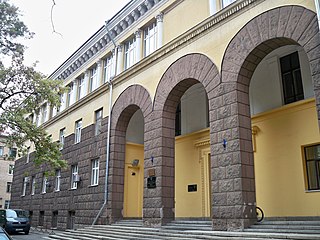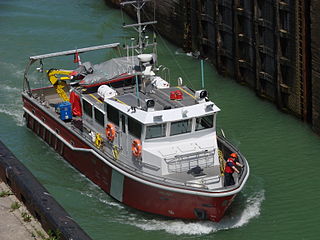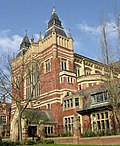Related Research Articles
CCG may refer to:
Computational archaeology describes computer-based analytical methods for the study of long-term human behaviour and behavioural evolution. As with other sub-disciplines that have prefixed 'computational' to their name, the term is reserved for methods that could not realistically be performed without the aid of a computer.
The Bioinformatics Centre is an interdisciplinary research in bioinformatics at the University of Copenhagen (UCPH). The centre is housed in the Section for Computational and RNA Biology at the Department of Biology within the Faculty of Science.

Computational sociology is a branch of sociology that uses computationally intensive methods to analyze and model social phenomena. Using computer simulations, artificial intelligence, complex statistical methods, and analytic approaches like social network analysis, computational sociology develops and tests theories of complex social processes through bottom-up modeling of social interactions.
E-Science or eScience is computationally intensive science that is carried out in highly distributed network environments, or science that uses immense data sets that require grid computing; the term sometimes includes technologies that enable distributed collaboration, such as the Access Grid. The term was created by John Taylor, the Director General of the United Kingdom's Office of Science and Technology in 1999 and was used to describe a large funding initiative starting in November 2000. E-science has been more broadly interpreted since then, as "the application of computer technology to the undertaking of modern scientific investigation, including the preparation, experimentation, data collection, results dissemination, and long-term storage and accessibility of all materials generated through the scientific process. These may include data modeling and analysis, electronic/digitized laboratory notebooks, raw and fitted data sets, manuscript production and draft versions, pre-prints, and print and/or electronic publications." In 2014, IEEE eScience Conference Series condensed the definition to "eScience promotes innovation in collaborative, computationally- or data-intensive research across all disciplines, throughout the research lifecycle" in one of the working definitions used by the organizers. E-science encompasses "what is often referred to as big data [which] has revolutionized science... [such as] the Large Hadron Collider (LHC) at CERN... [that] generates around 780 terabytes per year... highly data intensive modern fields of science...that generate large amounts of E-science data include: computational biology, bioinformatics, genomics" and the human digital footprint for the social sciences.
Computational science, also known as scientific computing, technical computing or scientific computation (SC), is a division of science that uses advanced computing capabilities to understand and solve complex physical problems. This includes
Computational economics is an interdisciplinary research discipline that involves computer science, economics, and management science. This subject encompasses computational modeling of economic systems. Some of these areas are unique, while others established areas of economics by allowing robust data analytics and solutions of problems that would be arduous to research without computers and associated numerical methods.

Spatial analysis is any of the formal techniques which studies entities using their topological, geometric, or geographic properties. Spatial analysis includes a variety of techniques using different analytic approaches, especially spatial statistics. It may be applied in fields as diverse as astronomy, with its studies of the placement of galaxies in the cosmos, or to chip fabrication engineering, with its use of "place and route" algorithms to build complex wiring structures. In a more restricted sense, spatial analysis is geospatial analysis, the technique applied to structures at the human scale, most notably in the analysis of geographic data. It may also be applied to genomics, as in transcriptomics data.
Geomorphometry, or geomorphometrics, is the science and practice of measuring the characteristics of terrain, the shape of the surface of the Earth, and the effects of this surface form on human and natural geography. It gathers various mathematical, statistical and image processing techniques that can be used to quantify morphological, hydrological, ecological and other aspects of a land surface. Common synonyms for geomorphometry are geomorphological analysis, terrain morphometry, terrain analysis, and land surface analysis. Geomorphometrics is the discipline based on the computational measures of the geometry, topography and shape of the Earth's horizons, and their temporal change. This is a major component of geographic information systems (GIS) and other software tools for spatial analysis.

Dorodnitsyn Computing Centre, known as the Computing Centre of the Academy of Sciences until 2015, is a research institute of the Russian Academy of Sciences of the Soviet Union. It was established in 1955.

Computational Engineering is an emerging discipline that deals with the development and application of computational models for engineering, known as Computational Engineering Models or CEM. Computational engineering uses computers to solve engineering design problems important to a variety of industries. At this time, various different approaches are summarized under the term Computational Engineering, including using computational geometry and virtual design for engineering tasks, often coupled with a simulation-driven approach In Computational Engineering, algorithms solve mathematical and logical models that describe engineering challenges, sometimes coupled with some aspect of AI, specifically Reinforcement Learning.
Specialized wind energy software applications aid in the development and operation of wind farms.
William Edwin Ricker, was a Canadian entomologist and important founder of fisheries science. He is best known for the Ricker model, which he developed in his studies of stock and recruitment in fisheries. The model can be used to predict the number of fish that will be present in a fishery. He also had an international standing as an entomologist and a scientific editor. He published 296 papers and books, 238 translations, and 148 scientific or literary manuscripts. His 1958 publication, "Handbook of computation for biological statistics of fish populations" and later updates were the standard books on the subject for decades.

CCGS Kelso is a scientific research vessel operated by the Canadian Coast Guard from CGS Base Burlington in the Central and Arctic Region of Canada. She was commissioned on September 8, 2009, by Terence Young, Member of Parliament for Oakville, at the Canadian Centre of Inland Waters in Burlington. The vessel was built by ABCO Industries Lunenburg Shipyard to replace the retiring CCGS Shark. The ship is named for the late Dr John Kelso, a noted scientist with the Department of Fisheries and Oceans, the parent department for the Coast Guard.
The School of Geography is part of the Faculty of Environment at The University of Leeds based in the UK.
Stan Openshaw was a British geographer. His last post was professor of human geography based in the School of Geography at the University of Leeds. After eighteen years at Newcastle University, including three years as professor of quantitative geography, he moved to work in Leeds in 1992. Openshaw was a researcher in computer-based/computational geography and his work aimed to automate aspects of geographical research and reduce subjectivity in geographical analyses. He worked on geographical information systems, analysis technology and models. He debated the direction geography should take putting forward a view that the subject needed an applied and scientific edge that harnessed the growing power of computers to make positive impacts to help us avoid and mitigate risk and cope better with disasters.
Deep linguistic processing is a natural language processing framework which draws on theoretical and descriptive linguistics. It models language predominantly by way of theoretical syntactic/semantic theory. Deep linguistic processing approaches differ from "shallower" methods in that they yield more expressive and structural representations which directly capture long-distance dependencies and underlying predicate-argument structures.
The knowledge-intensive approach of deep linguistic processing requires considerable computational power, and has in the past sometimes been judged as being intractable. However, research in the early 2000s had made considerable advancement in efficiency of deep processing. Today, efficiency is no longer a major problem for applications using deep linguistic processing.
Computational social science is the academic sub-discipline concerned with computational approaches to the social sciences. This means that computers are used to model, simulate, and analyze social phenomena. Fields include computational economics, computational sociology, cliodynamics, culturomics, nonprofit studies, and the automated analysis of contents, in social and traditional media. It focuses on investigating social and behavioral relationships and interactions through social simulation, modeling, network analysis, and media analysis.
Computational Geometry, also known as Computational Geometry: Theory and Applications, is a peer-reviewed mathematics journal for research in theoretical and applied computational geometry, its applications, techniques, and design and analysis of geometric algorithms. All aspects of computational geometry are covered, including the numerical, graph theoretical and combinatorial aspects, as well as fundamental problems in various areas of application of computational geometry: in computer graphics, pattern recognition, image processing, robotics, electronic design automation, CAD/CAM, and geographical information systems.
Julio Collado-Vides is a Guatemalan scientist and Professor of Computational Genomics at the National Autonomous University of Mexico. His research focuses on genomics and bioinformatics.
References
- ↑ "Centre for Computational Geography Website" . Retrieved 24 May 2011.
